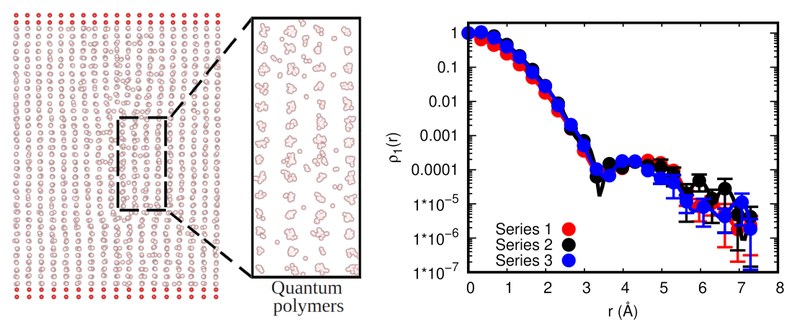Are dislocations in solid helium “supersolid”?
Feb 08, 2023
A team of researchers from the Universitat Politècnica de Catalunya (Spain), Universidade Estadual de Campinas (Brazil) and Stanford University (USA) performed advanced quantum atomistic simulations to assess the Bose-Einstein condensate fraction of solid helium at zero temperature containing dislocations, a defective system that previously had been proposed to be “supersolid”
At normal pressure, liquid 4He becomes superfluid at temperatures below ≈ 2.17 K. In the superfluid state, helium displays zero viscosity so that when is stirred vortices form in its interior that rotate indefinitely. Helium's superfluidity goes accompanied by a transformation called Bose-Einstein condensation, in which the wave function of individual particles overlap until they become a single entity: Atoms abandon their individuality to act in unison as a swarm. During more than half a century, physicists have squeezed their brains to determine whether the existence of superfluidity in a solid-phase system, known as supersolidity, was also possible or not.
In 2004, researchers from Pennsylvania State University (USA) observed phenomena in solid 4He that could be interpreted as a “supersolid” manifestation. They measured non-classical rotational moment of inertia (NCRMI) for a torsional oscillator filled up with solid helium and cooled down to ≈ 0.1 K. However, further experiments questioned the existence of a true supersolid since it was shown that the observed NCRMI could be explained in terms of changes in the elastic properties of helium. In 2012, the original 2004 experiments were repeated with a new setup designed to eliminate any elastic contributions, and this time no evidence of supersolidity was found.
Still, the possibility of intrinsic supersolidity in 4He was not completely ruled out due to a variety of mass flux experiments that reported flow of matter across solid helium samples. It was proposed that mass flow could be mediated by a network of interconnected, one-dimensional and supersolid dislocations, a common type of defect in helium crystals. This interpretation relied on the results of quantum simulation studies concluding that the cores of a particular type of dislocations were superfluid at ultralow temperatures.
In a recent study published in Physical Review Letters, the researchers Claudio Cazorla and Jordi Boronat from the Universitat Politècnica de Catalunya along with collaborators from the Universidade Estadual de Campinas and Stanford University, have demonstrated by means of advanced quantum simulation methods and realistic dislocation cells that the Bose-Einstein condensate fraction of 4He dislocation cores at zero temperature is null. Thus, based on these latter results, defective solid helium neither can be supersolid. These results provide compelling evidence for the absence of intrinsic superfluidity in dislocation cores in 4He and challenge the superfluid dislocation-network interpretation of the mass-flux-experiment observations, calling for further experimental investigation.

Share: